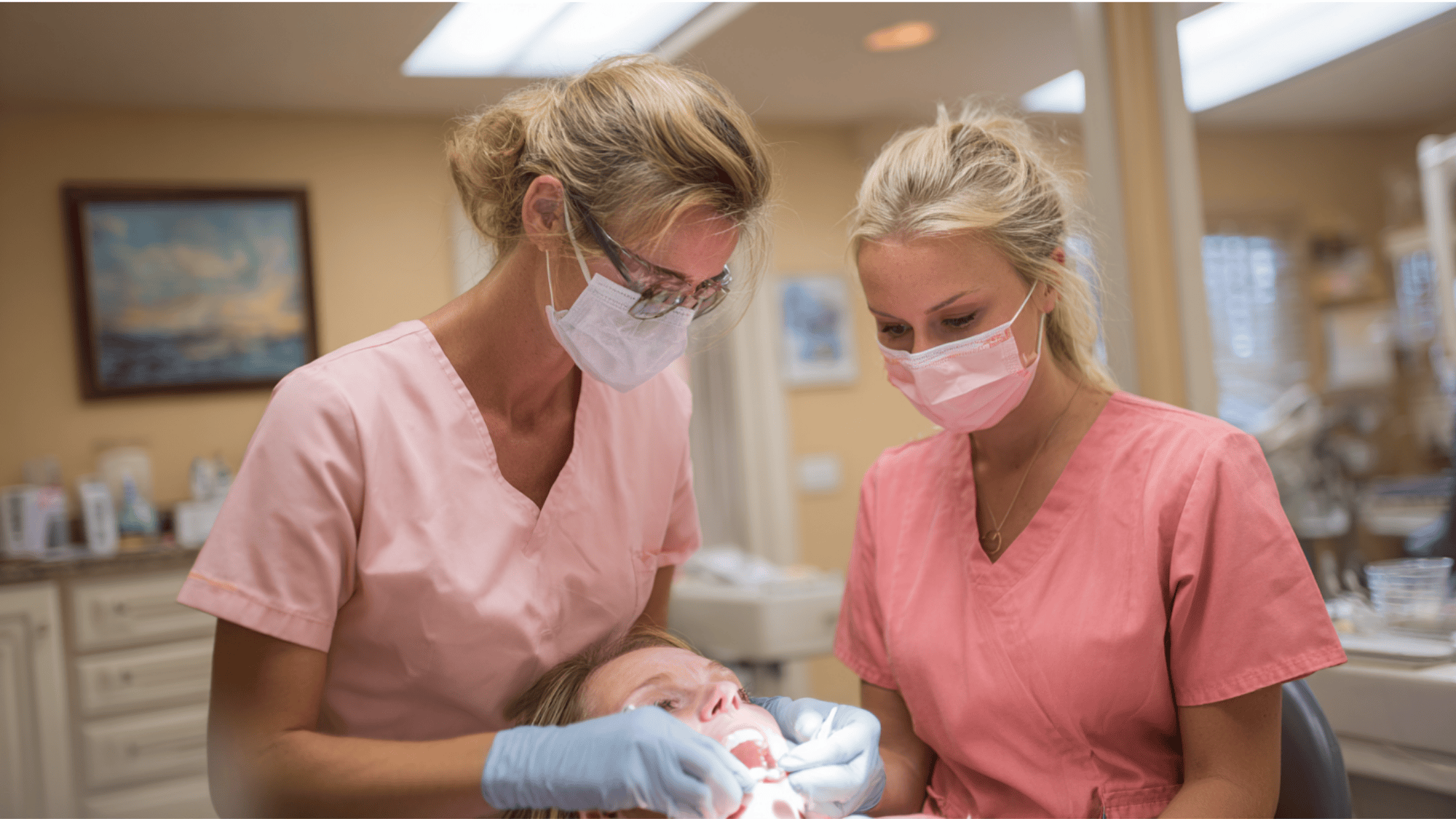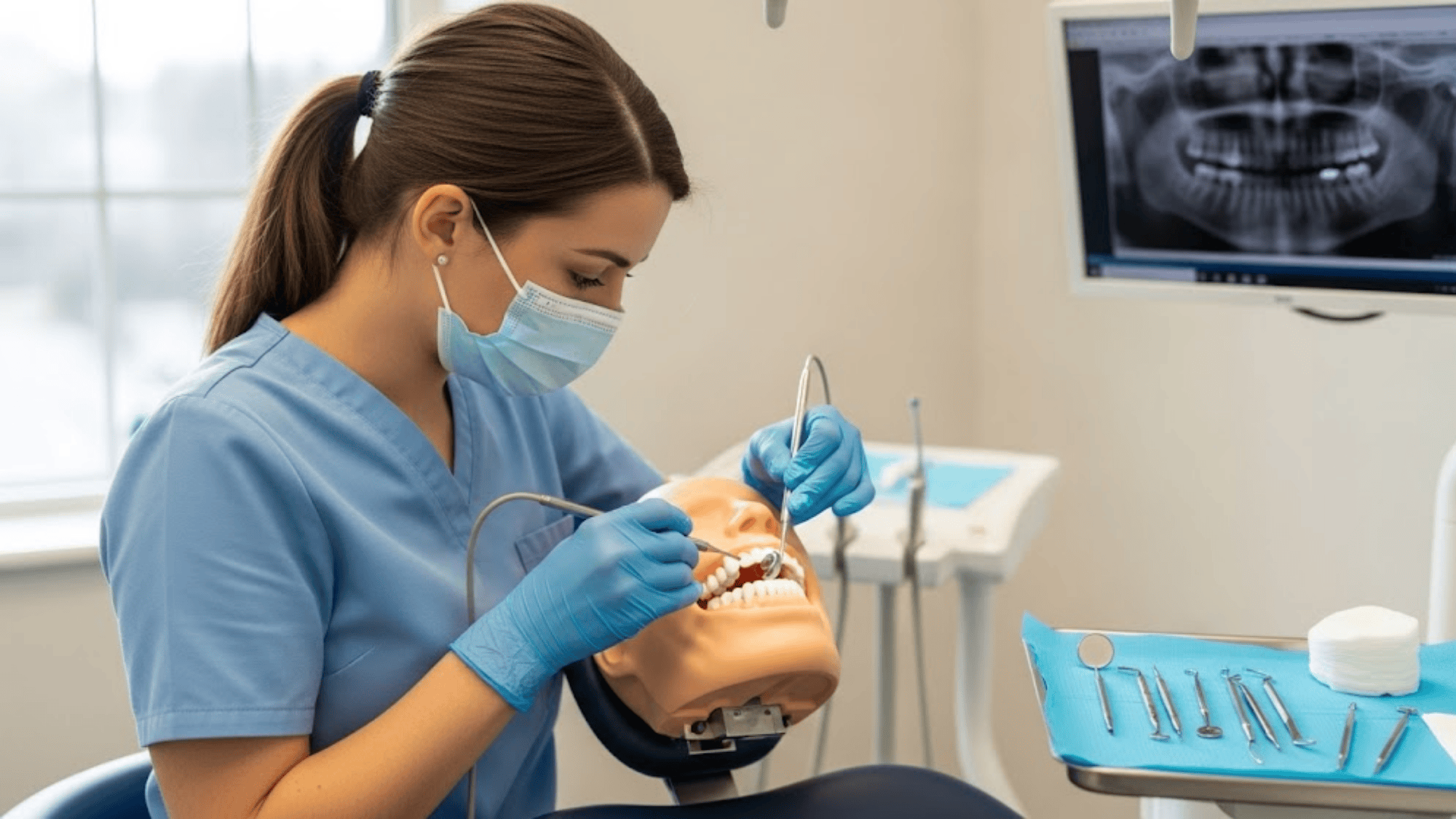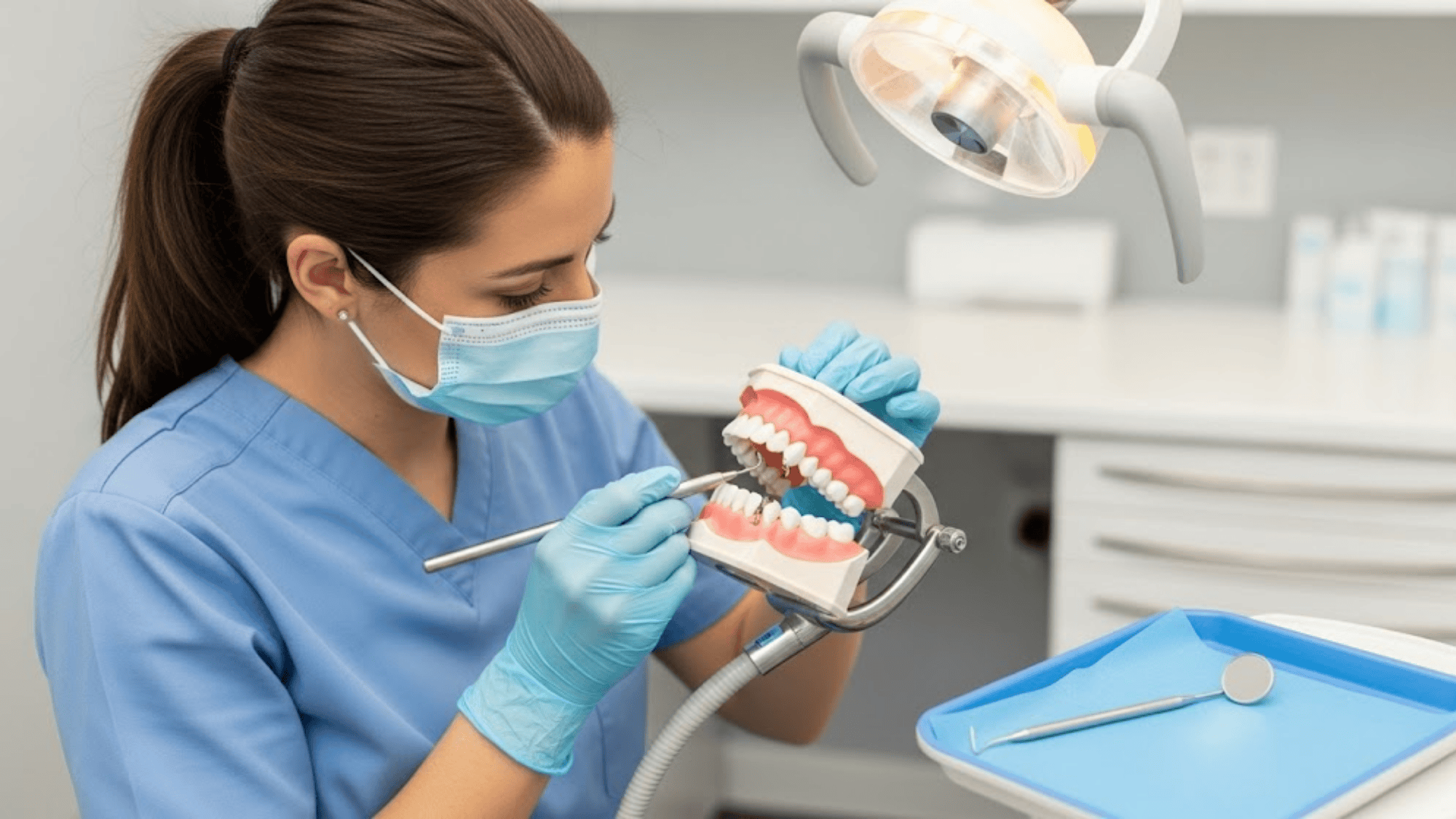Thinking about becoming a dental assistant but worried about the dental assistant program cost? You’re not alone. Many people want to enter this rewarding healthcare field, but need to understand the financial commitment first.
The good news is that dental assistant certification is one of the most affordable ways to start a healthcare career.
Unlike becoming a doctor or nurse, you don’t need a four-year degree or tens of thousands in student loans.
There are options for every budget, from online programs under $1,000 to community college courses.
Plus, with financial aid, scholarships, and payment plans available, the path to certification is more accessible than you might think.
Dental Assistant Training Expense
Not all dental assistant programs are created equal when it comes to cost. The answer varies widely depending on your choice of school type.
It can be the difference between paying under $1,000 or over $30,000 for the same career outcome.
Community College Programs
Community colleges offer some of the best value for dental assistant training. Dental assistant community college programs often range from $3,000 to $6,000.
This cost typically covers everything you need: tuition, lab fees, textbooks, and clinical supplies.
Most community college programs take 12 to 24 months to complete and offer either a certificate or an associate’s degree.
The longer timeline means smaller class loads, making it easier to work part-time while studying. In-state residents usually pay significantly less than out-of-state students, so check your local options first.
Private Vocational Schools
Private dental assistant schools cost more upfront but offer faster completion times. Expect to pay $8,000 to $15,000 for these programs, which typically last 9 to 12 months.
Many private schools use accelerated schedules with intensive training, allowing you to enter the workforce sooner.
These schools often provide all-inclusive pricing that covers books, supplies, and sometimes even uniforms.
While more expensive, the quicker timeline means you’ll start earning sooner, which can offset the higher tuition costs.
Online Certificate Programs
Online programs offer the most flexibility and often the lowest costs. Here are some popular options:
- Penn Foster: Currently $839
- U.S. Career Institute: Currently $1,239. Includes the RDA exam fee (a $150 value)
- Community College of Philadelphia: $2,999 total program cost
Online dental assistant training programs usually prepare you to earn your certificate by taking the Dental Assisting National Board (DANB) Certified Dental Assistant (CDA) exam.
Most online programs require you to complete an externship at a local dental office, which you’ll need to arrange yourself.
The main advantage is self-paced learning – you can finish faster if you have more time to study, or take longer if you’re balancing work and family responsibilities.
However, you’ll need to be self-motivated and comfortable with online learning.
Associate Degree Programs
For those wanting the most complete education, associate degree programs cost $6,000 to $30,000, depending on whether you attend a public or private institution.
These two-year programs provide the deepest knowledge base and may open doors to supervisory roles or specialized positions.
While associate degrees cost more and take longer, most employers view certificate programs as equal to associate degree programs.
Consider your career goals carefully if you want to start working quickly; a certificate program is usually sufficient.
The key is choosing a program that fits your budget, timeline, and learning style.
Certification Exam Fees
After completing your dental assistant program, you’ll need to pass a certification exam to work in most states.
These exams validate your skills and knowledge, making you more attractive to employers and often leading to higher pay.
Here’s what you can expect to pay for the most common dental assistant certifications.
| Certification Type | Initial Exam Cost | Annual Renewal | Best For | Requirements |
|---|---|---|---|---|
| DANB Certified Dental Assistant (CDA) | $450 | $75 | Experienced assistants | Approved training OR 3,500 supervised hours |
| NELDA (National Entry Level) | $400 | $75 | New/less experienced assistants | 300-3,000 hours of experience OR recent training |
| Registered Dental Assistant (RDA) | $150-$179 | Varies by state | State-specific roles | Varies by state (Texas example shown) |
Additional Required Costs:
- CPR Certification: $50-$150 (required for most exams)
- Background Check: $25-$75 (required for some certifications)
- Human Trafficking Course: Often free with RDA registration
The DANB CDA certification is the most widely recognized and accepted across the United States, making it worth the higher upfront cost if you plan to work in multiple states or want maximum job flexibility.
NELDA serves as a stepping stone for newer assistants, while RDA certifications are state-specific but often less expensive.
Factor these exam costs into your total training budget, as they’re essential for launching your dental assisting career.
Can’t Afford Dental Assistant Training? Here’s How to Get Help

Don’t let cost concerns stop you from pursuing dental assistant certification. Multiple funding sources can significantly reduce your out-of-pocket expenses, and many students qualify for aid they didn’t know existed.
Most accredited dental assistant programs accept federal financial aid, and there are numerous scholarships specifically for healthcare students.
Federal Financial Aid
The federal government provides the largest source of student financial aid in the country. These programs are need-based and don’t require repayment (grants) or offer favorable terms (loans).
- FAFSA Eligibility: Complete the Free Application for Federal Student Aid to unlock most funding options
- Pell Grants: Up to $7,395 per year (no repayment required)
- Stafford Loans: Subsidized and unsubsidized options with favorable interest rates
- SEOG Grants: Supplemental Educational Opportunity Grants for high-need students
- Federal Work-Study: Part-time jobs to help pay for education expenses
Scholarships and Grants
Scholarships are free money based on merit, need, or specific criteria like career goals. Many dental assistant students overlook these opportunities, but hundreds of scholarships exist specifically for healthcare training.
- PDS Foundation Scholarship: Up to $5,000 for dental assistant students
- American Dental Association (ADA) Scholarships: Various amounts for dental field students
- National Dental Association (NDA) Scholarships: Focused on minority and underserved students
- School-Specific Programs: Many schools offer their own scholarship opportunities
- Workforce Development Grants: Some programs offer completely free training through state partnerships
Alternative Funding Options
If traditional financial aid doesn’t cover all your costs, several other funding methods can help bridge the gap.
These options often have more flexible eligibility requirements and can be combined with federal aid.
- Interest-Free Payment Plans – Monthly installments spread over the program duration
- Private Student Loans – Through schools’ lending partners for additional funding
- Employer Tuition Assistance – Some dental offices help pay for employee training
- Military Benefits – GI Bill and VA benefits accepted at many programs
- State Voucher Programs – SNAP or unemployment recipients may qualify for free tuition
The key to maximizing financial aid is applying early and checking multiple options. Students who submit their FAFSA before December often receive twice as many grants as those who wait.
Contact your chosen school’s financial aid office to discuss your specific situation many students are surprised to find they qualify for more assistance than expected.
Smart Ways to Reduce Your Dental Assistant Training Costs

Every dollar you save on training is money you can keep in your pocket or put toward your future.
With some strategic planning and smart choices, you can significantly reduce your dental assistant certification costs without sacrificing the quality of your education.
Here are proven ways to make your training more affordable.
1. Choose the Right Program Type
Certificate programs offer the same job opportunities as associate degrees but cost much less and take half the time.
Most employers view both equally, so unless you have specific career goals requiring a degree, stick with a certificate program.
Online programs can save you thousands compared to traditional classroom settings, especially when you factor in commuting and parking costs.
2. Maximize Your Financial Aid Strategy
Submit your FAFSA as early as possible. Students who apply before December receive twice as many grants as late applicants.
Apply for multiple scholarships rather than putting all your hopes on one big award.
Even small $500 scholarships add up quickly and are often easier to win than larger competitions.
3. Shop Smart for Supplies and Materials
Buy used textbooks from previous students or online marketplaces like Amazon and Chegg. Many schools allow sharing lab kits with classmates, cutting supply costs in half.
Check if your program includes uniforms and equipment in tuition before purchasing separately. Some schools also offer payment plans for supplies, spreading costs over several months.
4. Consider Community College Pathways
In-state community college tuition is typically 60-70% less than private schools. Look for evening or weekend programs that allow you to keep working part-time during training.
Some community colleges offer accelerated summer programs that can reduce your time out of the workforce.
5. Take Advantage of Free Resources
Look for workforce development programs in your area – some offer completely free dental assistant training in partnership with local dental offices.
Check if you qualify for state voucher programs, especially if you’re receiving unemployment or SNAP benefits. Many libraries offer free test prep materials and quiet study spaces.
Its a Wrap
Becoming a dental assistant can be a smart move if you want a stable job in healthcare without spending years in school.
There are many ways to keep costs low, from choosing affordable programs to finding help with tuition. The most important step is to plan ahead, ask questions, and check out every option.
Even if you’re just out of high school or changing careers, dental assisting offers a clear path to success.
With some research and effort, you can find a program that fits your life and your wallet, and start your new career with confidence.












